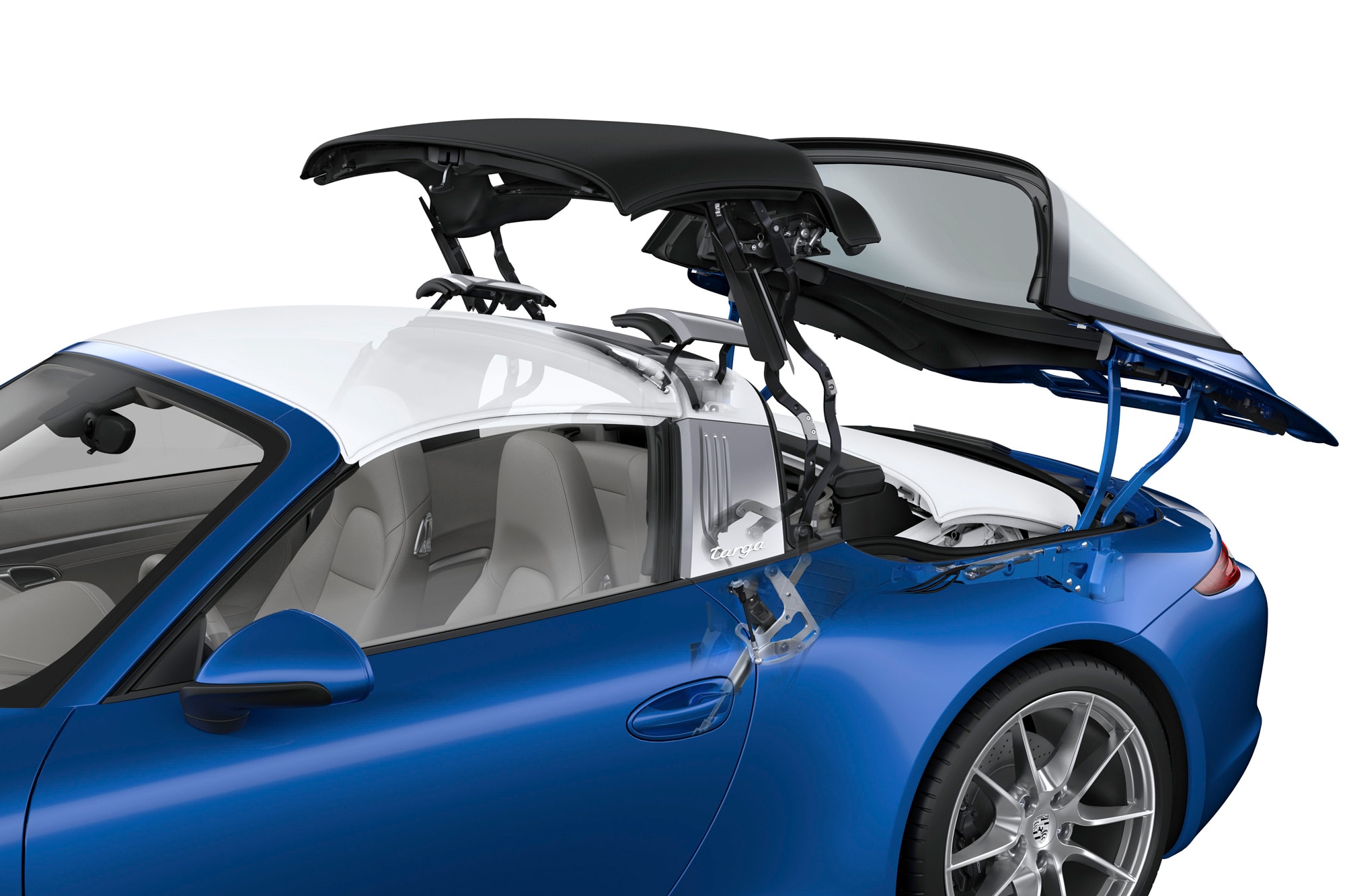What Is a Targa Top?
This Porsche-derived term has largely become a synonym for a removable roof panel.
 Porsche
Porsche
If you're looking for the open-air thrill of a convertible but still want to retain the feel of a fixed-roof coupe, perhaps something with a removable roof panel — or in Porsche's case, a targa top — is for you.
Take it off the car and you'll expose the front-seat passengers' heads to the sky while leaving the B-pillars and underlying roll-bar structure in place. Technically, only Porsches can have targa tops, as the term describes the specific roof design popularized by the 911 Targa. This is why you'll see car magazines refer to similar tops as "targa-like" or "targa-esque."
Porsche maintains that when it designed the 911 Targa's roof in 1965, it created "something completely new." In reality, a few automakers beat Porsche to market with lift-off hard-top coupes — such as Fiat, with its limited-production 1958 1200 Wonderful; Triumph, with the 1961 TR4; and Toyota, with the 1965 Sports 800 micro sports car — but none managed to do so in such a memorable manner.
Porsche Kicked Off a Trend
Fearing the United States would introduce safety standards banning open convertible designs, Porsche sought to make an open-air version of its new 911 sports coupe that would incorporate a roll bar over the cabin for strength and crashworthiness.
The finished design, launched in autumn 1966 as the 911 Targa in honor of Porsche's success in the Targa Florio race, featured a removable roof panel over the front seats and a thick B-pillar that wrapped over the car, forming a roll hoop. Initially, the rear window was plastic and could be removed to increase airflow, but a fixed glass window was introduced in 1967 and became standard by 1968.
Most U.S. automakers dropped convertibles from their portfolios in the mid-1970s due to dwindling interest. Both the Chevrolet Corvette and Ford Mustang — which had offered convertible models since their debuts — ditched droptops in favor of T-bar or T-top roofs, which resembled a targa top but split the removable roof panel in two.
The supposed death of the droptop was hyperbolic and fairly short-lived. Porsche launched a proper convertible 911 in 1982, and soon after, both the Mustang and the Corvette returned to their ragtop roots. But while targa-type tops were initially intended to replace convertibles, they had become popular in their own right, and automakers kept building them.
The Corvette gained a one-piece lift-off roof panel in 1984 and continues to have such a feature today. Acura added a removable hard top to its NSX sports car for the 1995 model year, and while its marketing team couldn't utter the word targa without receiving a flurry of cease-and-desist letters from Stuttgart, it was no secret what the suffix in NSX-T meant.
Moreover, the Toyota Supra offered a removable Sport Roof in its third and fourth generations. While today’s GR Supra is available only as a fixed-roof coupe, Toyota’s one-off 2021 SEMA concept shows that the automaker is aware that a targa-style top still resonates with enthusiasts.
How a Targa Top Works
A lot of targa-style panels require manual unlatching and removal, but over the years, many automakers have automated the process.
For instance, while the U.S. market Honda Civic Del Sol came exclusively with a manually removable roof panel, elsewhere in the world, the car could be ordered with a mechanized TransTop roof. It’s a complicated design, where the trunklid rises up to the level of the roof and extends forklift-like arms to grab the panel. After the driver latches the top to the arms, they retract into the trunklid, taking the panel with them. The whole assembly then descends back into the car.
Porsche itself joined the automated craze in 1996, eliminating the familiar 911 Targa roof design in favor of a large glass sunroof panel that slid beneath the rear window. The targa design introduced in 2014 was sort of a return to form, looking a lot like the original, but the car uses a dramatic and complex mechanism to store its roof panel.
The Pros and Cons of Targa Tops
In their infancy, cars with targa-style tops had some advantages over convertibles of the day — namely, increased structural rigidity and the superior rearward visibility that comes with having a back window. Neither vehicle will be particularly quiet inside, but that's the price you pay for open-air motoring.
One disadvantage of a targa top is that, when stowed, it typically eats up a fair amount of cargo room. This is true of convertibles as well, but while soft tops can fold, targa panels cannot.
In rare cases, the vehicle may not even have a place to stash the top. The short-lived Pontiac Solstice GXP Coupe raked, tapered roofline looked great but prevented onboard storage of the roof panel. Owners had to remove and stow it elsewhere before going out — and pray the weather didn't change during their drive.
Written by humans.
Edited by humans.
 Evan McCausland
Evan McCauslandCar, truck, train, or bus—if a vehicle has wheels, chances are Evan McCausland is interested in it. More importantly, he’s interested in helping others learn more about cars and trucks, especially when it comes time to make a decision on their next vehicle purchase. For nearly two decades, he’s been fortunate to have the opportunity to do just that, writing for major automotive publications, automotive clubs, and automakers alike.
Related articles
View more related articles